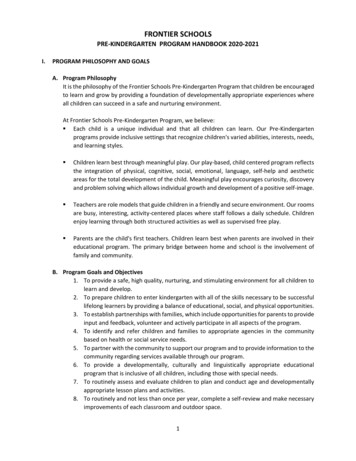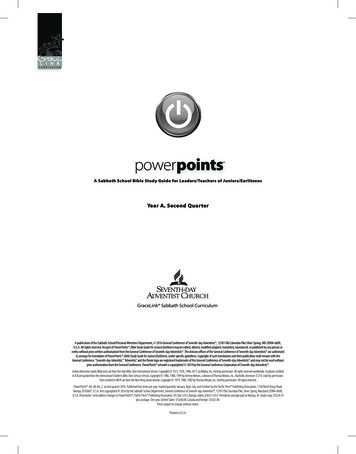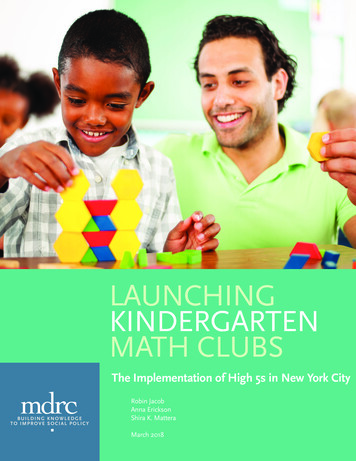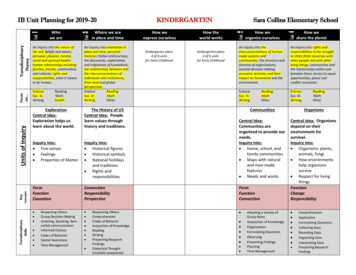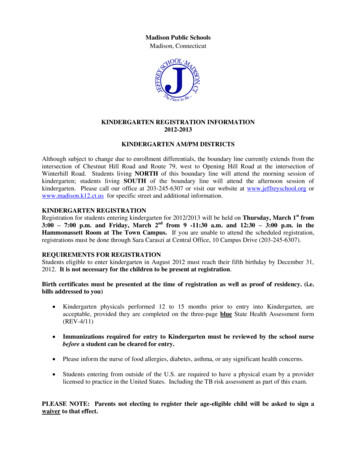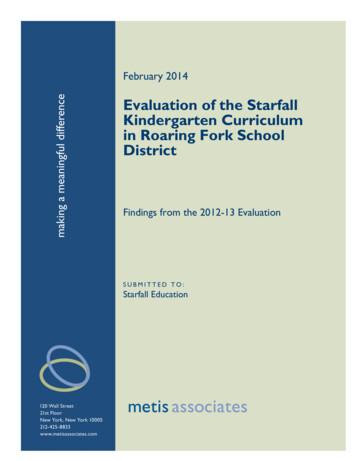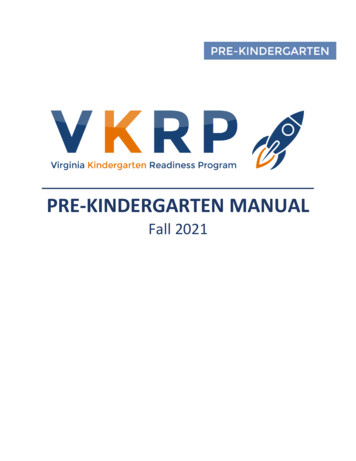
Transcription
PRE-KINDERGARTEN MANUALFall 2021
Dear Pre-Kindergarten Teacher,Welcome to the Virginia Kindergarten Readiness Program (VKRP) for Pre-K.We hope that you have had an opportunity to recharge this summer and are excited to begin the 2021-2022 school year.As a teacher, you play a critical role in the physical, social-emotional, and cognitive development of Virginia’s children.Children enter pre-k having had many different experiences and exposure to early learning opportunities. This isespecially true this year, as the global pandemic has led to disruption, stress, and in some cases, trauma, for ouryoungest learners. Teachers may find even larger variations in children’s early learning and social-emotional skills inclassrooms this year. As a result, many children will need tailored academic and social-emotional support across theschool year to continue building skills that they will use in kindergarten and beyond. Last fall, data from the VirginiaKindergarten Readiness Program (VKRP) showed that 45% of Virginia’s kindergartners started the school year needingsupport to build foundational skills in literacy, math, self-regulation, and/or social skills.VKRP gives teachers, schools, and families valuable information about children’s skills in four key areas: Mathematics(measured using the Early Mathematics Assessment System; EMAS), Literacy (measured using the PhonologicalAwareness Literacy Screening; PALS (pals.virginia.edu)), and teachers’ perceptions of Self-Regulation and Social Skills(measured by the Child Behavior Rating Scale; CBRS). Additionally, there are items for teachers to report on theirperceptions of children’s well-being.Centers, schools, and teachers can use data to help inform instructional decisions that will support children’s learningand social-emotional development. VKRP and other formative and summative assessment data can be used to planinstruction at the group and individual child’s levels. Having information on children’s academic and social-emotionalskills, and their well-being will help teachers, schools, and divisions identify barriers to equity and better individualizesupport for children’s developmental needs. It is critical, now more than ever, that these data are used to informinstructional decisions that are responsive to the trauma, stress, and disruption that children have experienced due toCOVID-19.We have created this manual to help you learn about and maximize your use of the assessments, reports, andresources that make up the VKRP system.As the state’s public health conditions evolve, VKRP will keep you updated with any changes to administration guidance.Thank you for your commitment to your children’s well-being and success. We know that this will be another uniqueyear and are here to support you. Please reach out to us with any questions or comments via our toll-free hotline 866301-8278 ext. 1 or vkrp@virginia.edu or our online chat while you are in the VKRP web portal.Best regards,Amanda Williford, PhDVirginia Kindergarten Readiness Program
ContentsContents . 4Introduction . 1Using VKRP in Mixed-Age Classrooms . 2Navigating to VKRP . 3How to Prepare for VKRP . 6The Early Mathematics Assessment System (EMAS) . 8In-person EMAS. 10Remote EMAS . 15EMAS Administration Considerations . 24The Child Behavior Rating Scale (CBRS) . 26CBRS Administration Considerations . 27Reports . 30Resources . 37Family Support . 39Troubleshooting Technical Issues/Contact Us . 40Appendix A: Fall EMAS Items and ELDS/ Trajectory Alignment . 41Appendix B: Copy of CBRS and Applicable ELDS Alignment . 43Appendix C: Understanding the CBRS as a Teacher Rating Scale: Recognizing and Reducing the Impact ofTeacher Bias . 48Appendix D: Using VKRP with English Language/Multilingual Learners. 52
1IntroductionVirginia Kindergarten Readiness ProgramProject OverviewThe Virginia Kindergarten Readiness Program (VKRP) provides teacher, families, and school leaders with anunderstanding of children’s school readiness skills in four key areas: Mathematics (measured using the EarlyMathematics Assessment System; EMAS), Literacy (measured using the Phonological Awareness LiteracyScreening; PALS (pals.virginia.edu)), and teachers’ perceptions of Self-Regulation and Social Skills (measuredby the Child Behavior Rating Scale; CBRS). It also includes tools to support early learning. At its core, VKRP is aset of coordinated assessments, a reporting system, and a set of instructional resources.HistoryVKRP was initiated by Elevate Early Education (E3), a statewide, bipartisan, issue-advocacy organizationdedicated to early childhood education. E3, in partnership with the University of Virginia's Center forAdvanced Study of Teaching and Learning (CASTL) and with guidance from the Virginia Department ofEducation, launched a three-phase approach to creating a statewide, comprehensive kindergartenassessment. In Phase I, CASTL researched and selected assessment tools that could be used statewide toaccurately assess readiness skills across a range of domains upon kindergarten entry. During Phase II, VKRPwas administered to a group of students who were representative of kindergartners across theCommonwealth, and data indicated that 34% of children arrived at kindergarten unprepared in at least onecritical learning domain (literacy, math, self-regulation, and social skills). These results were reported to theVirginia State Legislature which allocated funding to begin statewide implementation of the expandedassessments to provide a more comprehensive snapshot of kindergarten children’s incoming skills. Phase IIIhas included a gradual statewide roll-out of VKRP, allowing for input from administrators and teachers as wellas expansion of VKRP to include the beginning and end of kindergarten. In 2018, the Virginia General Assemblypassed legislation that requires all kindergarten students to be assessed using VKRP in the fall and spring ofthe 2019-2020 school year and annually thereafter (HB5002, Item 128, H.) and to develop a version of VKRP touse in assessing pre-kindergartners (HB5002, Item 340, Q.). In Fall 2019, 80 public and private preschoolclassrooms piloted VKRP. During the 2020-2021 school year, all public preschools had the opportunity to useVKRP to assess children’s self-regulation and social skills.PresentIn 2021-2022, VKRP will be administered statewide in the fall and spring of kindergarten. Beginning Fall 2021,all four-year old children enrolled in VPI classrooms must be administered VKRP assessments in the fall andthe spring of the year. This requirement also applies to children that are enrolled in a VPI classroom, but whomay not be funded through VPI state dollars (e.g., ECSE children; locally funded children in a classroom that issupported by VPI; VPI children enrolled in a community-provider setting) and Virginia Early ChildhoodFoundation (VECF) Mixed Delivery Classrooms. (Superintendent’s Memo, #159-21)
2Using VKRP in Mixed-Age ClassroomsThere will be some mixed age classrooms participating in VKRP this fall. For teachers in mixed age classrooms(3s and 4s), there are currently two options for completing VKRP assessments with children. School Divisionsand Programs can determine their guidance to teachers within these options:1. Assess 4-year-olds but not 3-year-olds: Include only your 4-year-old children (turned four on or beforeSeptember 30) on classroom lists in PALS. Complete the PALS, EMAS, and CBRS assessments for all 4year-old children on the PALS class list.2. Assess 3-year-olds using only CBRS: Include all children (3-year-olds and 4-year-olds) on the class listsin PALS. In this case, teachers will complete the PALS, EMAS, and CBRS assessments for all 4-year-olds(turned four on or before September 30) on the PALS class list. For 3-year-olds, there is not currentlyan age-appropriate version of the PALS and EMAS (these will be available fall 2022). However, teachersdo have the option of completing the CBRS assessment for 3-year-old children. This is not required.Information on using the CBRS with 3-year-olds: The CBRS has been used with 3-year-old children and hasbeen shown to be reliable and valid with this age group. Therefore, teachers may complete the CBRS for 3year-old children in their classroom. If teachers use the CBRS with 3- and 4-year-old children in theirclassroom, there may be a wide range of scores on the measure because 3- and 4-year-olds are at differentplaces in their development of self-regulation and social skills. The Interpreting Reports document (available inSeptember) will provide helpful guidance for how to interpret data from the CBRS in mixed age classrooms.
3Navigating to VKRPVKRP and PALS work together to provide you with an efficient online assessment experience—one login andpassword to remember (PALS) and one entry or upload of your class roster. Classroom information entered inPALS is automatically shared with the VKRP web portal. Verify that your class list is current in PALS before theVKRP window opens to account for all your children. Any update to your classroom information is done on thePALS website.1. Log into your PALS account using your email and PALS password.2. Once you’re logged into PALS, select the VKRP tab on the menu bar. This action will take you to theVKRP web portal, where you can access all components of VKRP: assessments, reports, and resources.
4VKRP Web Portal DiagramOnce you click on the red VKRP tab on the PALS website, you will be directed to the VKRP web portal displayedbelow.
5VKRP Web Portal StructureUse this key in conjunction with the diagram on the previous page to identify the various features of the VKRPsystem:A. Home – links to the homepage of the VKRP web portal; the landing pageB. Assessment Guides – links to Fall and Spring versions of the VKRP Essential Documents, EMAS VideoDemonstrations, and Practice Assessments pagesC. Training – links to Teacher Training Checklist and My VKRP Training Modules pagesD. Reports – links to My Reporting Dashboard and Understanding Reports pagesE. Instructional Resources – links to Resources Overview, Geometry, Patterning, Numeracy, Computation,Self-Regulation, and Social Skills resource pagesF. Help – links to FAQs and Contact Us pagesG. Connect to PALS – links back to the PALS homepageH. Announcements – displays important notificationsI. Training Checklist – lists three reminders that links to resources to help prepare for VKRP assessments.For returning VKRP users, this section may not display if you have previously selected “Yes, I’m all set.”J. View Classroom Reports – links to all classroom-level reports within the reporting dashboardK. Student list – displays the classroom roster in alphabetical orderL. Overall status – a blue check mark appears in this column to indicate that data (i.e., exemption orcompleted assessment) has been entered for both the EMAS and CBRS for a child.M. EMAS assessment – entry point to the In-Person and Remote math assessments (both available inEnglish and Spanish)N. CBRS assessment – entry point to the self-regulation and social skills assessmentO. Student reports – links to all student-level reports for the selected childP. Tracking panel – key to the status of each assessmentQ. Manage your classroom list via PALS – links back to the PALS website where changes or updates toclassroom rosters are made
6How to Prepare for VKRPRead the Program ManualRead this manual in its entirety.Complete the Training Modules/Complete the Remote EMAS Training ModuleAn in-person or online training is required to administer the VKRP assessments. Even if you have alreadycompleted an in-person or online training, it is a good idea to revisit the online training modules to refreshyour knowledge and skills. To access, select Training My VKRP Training Modules VKRP Training. Modulescan be completed in any order and viewed multiple times.Watch a Video Demonstration of the In-person and/or Remote EMASThere are two sets of demonstration videos: 1) In-person and 2) Remote. We strongly recommend that youwatch the video demonstration of the EMAS that corresponds with the assessment version(s) that you areplanning to administer. To access these, select Assessment Guides EMAS Video Demonstrations.
7Try a Practice AssessmentSelect Assessment Guides Access Practice Assessments on the menu bar. Then, select the assessment youwould like to practice: In-person EMAS, In-person Spanish EMAS, Remote EMAS, Remote Spanish EMAS, orthe CBRS. You should practice the in-person and/or remote version of the EMAS to become familiar with thequestions, flow of the assessment, and manipulatives required. You should practice the CBRS to learn thebehaviors you will observe and rate for each child.Verify Classroom Roster in PALSVerify that your class list is current in PALS before the VKRP window opens to account for all your children. Anyupdates to your classroom roster are done through the PALS website.
8The Early Mathematics Assessment System (EMAS)What is the EMAS?The Early Mathematics Assessment System (EMAS) is a reliable and valid, research-based assessment of earlymathematical thinking, that draws on modern cognitive science as well as developmental and educationalresearch. Created by Dr. Herb Ginsburg and colleagues at Teachers College, Columbia University, 1 andexpanded and adapted by researchers at CASTL, the EMAS is designed to measure a broad range ofmathematical content.EMAS at a glance1 This fall, teachers will have the option of administering the In-person or the Remote EMAS to children.When possible, the preferred version of administration is the In-person EMAS. Teachers administer the assessment to children individually, using a flip book (in-person) orPowerPoint slides (Remote EMAS) and specific manipulatives. The assessment takes approximately 20-25 minutes per child to administer. Items are designed to capture a wide range and variety of early math skills. Children are not expectedto get all items correct. It uses hands-on materials to engage children and to help teachers observe children’s thinking. It is aligned with Virginia's Early Learning and Development Standards (ELDS; 2021) and Clements andSarama’s Mathematics Learning Trajectories (2009)2. See Appendix A for a full list of Fall EMAS Itemsand ELDS/ Trajectory Alignment.Ginsburg, H. P., Pappas, S., & Lee, Y. (2010). Early Mathematics Assessment System. An unpublished assessment measure createdas part of the NIH supported project Computer Guided Comprehensive Mathematics Assessment for Young Children (Projectnumber 1 RO1 HD051538-01).2 Clements, D. H., & Sarama, J. (2009). Learning and teaching early math: The learning trajectories approach. New York: Routledge.
9Comparing the In-Person and Remote EMASIn-Person EMASRemote EMAS Available in English and Spanish Available in English and Spanish All tasks are administered in-person. Teacher uses a physical flip book and manipulativesand follows the script in the online application.A subset of tasks is administered virtually. Tasks thatcannot be administered virtually will be skipped. Teacher uses PowerPoint or Google Slides as anonline flip book and follows the script in the onlineapplication; children will need some manipulatives athome. There are modified administration directions andmaterials. Two devices (e.g., computer, iPad, etc.) arerecommended for teachers. Once the assessment is complete: Once the assessment is complete:ooThe EMAS will be considered “Complete” on thelanding page and reports.All EMAS data will be available in student andclassroom reports.oThe EMAS will be considered “Complete” on thelanding page and reports.oEMAS data will be available in student andclassroom reports.It is important to note that we do not have precise psychometric data on the remote version of theEMAS. Although the team worked hard to choose a set of items that can be reliably administered whilechildren are remote, we have not yet validated that the In-person EMAS and the Remote EMAS are equivalentmeasures.
10In-person EMASWhat skills are assessed with the Fall EMAS?The fall In-person EMAS consists of 33 items. The assessment is divided into foundational mathematics skillswithin the subdomains of Geometry, Patterning, Numeracy, and Computation:Module 1Module 2Module 3Module 4GeometryPatterningNumeracyComputation Shape Recognition Recognizing Patterns Shape Properties Reproducing Patterns Extending Patterns Counting andCardinality Subitizing Describing Changesin Sets Numerals Addition SubtractionHow to Administer the In-Person EMASBecause the In-person EMAS is a direct assessment that requires in-person administration, we are providingimplementation recommendations in accordance with health and safety guidelines.Step 1: Prepare for the Assessment Select an assessment location with good ventilation (i.e., an open area like a hallway or multipurposeroom where air can flow freely). Design your assessment space. Maximize the space between you and the child, at least three feetapart, while ensuring that you can see their responses. Use sheet protectors and/or laminate mats and pattern cards to make sanitizing easier after eachassessment, consider having children wear gloves, OR make copies of mats and/or patterning cards tobuild individual manipulative sets for children. These items can be downloaded within the VKRP webportal under Assessment Guides Essential Documents.Consult the list on the next page to ensure that your VKRP kit has all the necessary materials toadminister the fall In-person EMAS. Please inform your VKRP school contact of any missing items sothey can place an order for you.
11Assorted materialsPattern cardsShape manipulativesMats1 – Flipbook pages5 – Dog1 – Equilateral triangle1 – Subitizing 4 & 61 – Dry-erase marker5 – Basketball1 – Square1 – Laminated animals20 – Chips4 – Flowerpot3 – Number cards 4, 7, 88 – Cupcake1 – Ten frameStep 2: Start the Assessment Sanitize the assessment area and all materials, using EPA-registered household disinfectant, prior toselecting a child to work with you. Follow your school’s guidelines for mask wearing. Wash your hands with soap and water or use hand sanitizer before starting the assessment. Instructyour child to do the same. Select the child and assessment.o First, click the EMAS button next to your child’s name.o Then, click the drop-down arrow to choose the assessment version you will administer.o Select “English In-Person or Spanish In-person.”o Verify that you have chosen the correct version and click “Begin.”
12 Verify the child’s name by selecting the “Confirm Student” button.o If you accidentally select the wrong child’s name, you can change to the correct name by clicking“Select Another Student,” which will display a dropdown of your class list. Select the administration condition.o Standard Administration In most cases, you will administer the assessment under standard conditions. To begin, selectthe green button, “Proceed with Standard Administration.”o Exempt or Non-Standard Administration In rare cases, a child may qualify as exempt from this assessment or need to be assessed usingnon-standard procedures. When you click “Select Exempt or Non-Standard Administration” youwill be given the following options: “Non-Standard” – Refer to the Administration Conditions Table on page 24 for moreinformation.
13 “Exempt”VKRP is a state-wide assessment tool that the Commonwealth of Virginia uses to measurereadiness and growth; therefore, all pre-kindergartners, including children with disabilities,are required to be assessed. Exemptions are rare; however, there are limited reasons forexemptions. From the drop-down menu, please select the reason for the exemption usingthe following criteria:i.For children with IEPs, the IEP team should discuss and establish what constitutessufficient evidence for an exemption based on disability.NOTE: An exemption from the PALS assessment does not automatically exempt achild from the EMAS. ii.A serious illness or medical condition which prevents a child from participatingduring the assessment period.iii.A family requests an exemption. In this case, it is important to inform families thatnon-participation means teachers and families will not receive information on theirchild’s skills and progress contained in the assessment score reports.iv.Other – Teachers should use this response only after consultation with theiradministrative team and will need to provide specific details in the text fieldprovided.Select the appropriate option from the drop-down and provide an explanation when prompted.Then, click “Submit.”
14Step 3: Administer the Assessment Administer each item.o Text in green is the script read aloud to children. Non-verbal instructions are in brackets. Adhere toboth verbal and non-verbal directions to maintain consistency in administration across children.o Some items begin with a demonstration (DEMO) to familiarize children with rules of the task. Theseitems are not scored. Record child’s response.o Correct response(s) is written in the green button and always listed first.o Possibly correct response(s) is written in the orange button. Children can receive a point if theyanswer correctly following a possibly correct scaffold.o Incorrect response(s) is written in the red button. Some incorrect responses lead to a follow-upquestion that helps children reach a correct answer; however, they typically do not receive creditat this point. Instead, you will see a “Correct with help, point not awarded” indicator on theirreport.o The previous button allows you to go back one question during the assessment. Pay attention to administration notes.o Some items note a timeframe, but the items are not timed. Please move on to the next step if thechild does not answer in the general time indicated.o Depending upon the child’s response, you may be prompted to give a scaffold or feedback. Take a break if needed.o The EMAS auto-saves responses. If a child needs a break, stop the assessment by clicking the Homebutton on the menu bar and resume at a later time/day. Press the submit button once you complete the assessment.o There is a textbox at the end of the EMAS where you can type in optional notes about theassessment (i.e., child’s use of strategies, math language). These notes will print with the TeacherComments Report. Be sure to press submit when finished.
15Remote EMASVKRP has adapted the EMAS for online administration when there is no option to assess a child in-person.Remote EMAS at a glance The Remote EMAS is an adaptation of the In-person EMAS assessment and can be conducted remotelywith children who are engaging in virtual learning. Most items in the In-person and Remote EMAS are the same. Some items have been adapted to work in a virtual setting. Some items will be skipped. The assessment should take approximately 15 minutes to complete. The Remote EMAS should only be used in cases where it is not possible to administer the In-personEMAS There are some differences in the information provided on VKRP reports for the In-person and RemoteEMAS.What skills are assessed with the Fall Remote EMAS?The fall Remote EMAS consists of 21 items. The assessment is divided into foundational mathematics skillswithin the subdomains of Geometry, Numeracy, and Computation:Module 1Module 2Module 3GeometryPatterningNumeracy Shape Recognition Shape Properties Recognizing Patterns Counting andCardinality Subitizing Numerals Describing Changes inSets
16Remote EMAS ItemsMany items on the In-person and Remote EMAS are the same. However, there are some items that are notfeasible to administer in a remote way. These items will either be skipped or adapted. Skipped items – Some items that require physical manipulatives to properly assess the skill will beomitted from the assessment to remove the challenge of administering them in a virtual setting. Adapted items – Other items have been slightly adapted to be administered virtually. These items willshow updated scripts or instructions.o The sample task below requires you to play a video within the PowerPoint instead of using thecorresponding subitizing mat used in the In-person EMAS assessment.o The sample task below has been adjusted to have fewer applicable response choices. Ignoreany extra buttons that say, “Do Not Click.”
17How to Administer the Remote EMASStep 1: Prepare for the Assessment Watch the VKRP Remote EMAS Training Module (Training My VKRP Training Modules RemoteEMAS Training). Watch the VKRP Remote EMAS Demo Video (Assessment Guides EMAS Video Demonstrations). Check the following materials list to ensure you have access to all the necessary supplies:Teacher materialsComputer with video & audio capability – twodevices recommendedReliable Internet accessVideo conference application (i.e., Google, Zoom)VKRP Fall Remote EMAS PowerPoint file*Student materialsComputer/laptop with video & audio capabilityReliable Internet accessVideo conference application (i.e., Google, Zoom)PaperPencil or other writing utensil* For the remote version of the EMAS, you will use a PowerPoint slide version of the flip book pagesthat you can download by selecting Assessment GuidesEssential Documents. Be sure to downloadthe PowerPoint file ahead of time. The file is large and may take time to download.Device Options:1. Two Devices (Recommended) – Any combination of laptops, desktops, monitors, and tablets can beused for this method. Whenever possible, we recommend using two devices when administeringthe Remote EMAS. One device connects to the child via a video conference application where youshare the PowerPoint slide deck with the child. A second device is used to access the onlineassessment application in the VKRP web portal where you read the script and enter responses.
18How to Setup your Devices and Screen ShareDevice A – Open the VKRP assessment portal. This iswhere you will access the assessment, read the script,and enter responses.Device B1. Download and open the VKRP Fall Remote EMASPowerPoint.2. Connect to your child via a video conferenceapplication.3. “Share Screen” the PowerPoint in SLIDE SHOWView so your child only sees the slide images.4. Select “Share Sound” to ensure that your child canhear the video in the PowerPoint.2. One Device – You can also administer the assessment using one device, though it is slightly morecomplex to set up. When sharing your screen with the child, it is very important that the child onlysees the PowerPoint slides, and NOT the VKRP assessment portal where you will be recordinganswers.How to Setup your Device and Screen Share1. Open the VKRP assessment portal in one browser.Resize the browser and place on one side of yourscreen.2. Download and open the VKRP Fall Remote EMASPowerPoint. Resize the PowerPoint and place onthe opposite side of the browser. Then, selectREADING View.3. Connect with your child via a video conferenceapplication.4. Select “Share Screen Advanced Portion ofScreen.” A green rectangle will appear, indicatingwhat your child will see. Fit the green rectangleover the slides only.Key Setup Reminders5. Select “Share Sound” to ensure that your studentcan hear the video in the PowerPoint. Make sure your device(s) are set up properly and that you can share screen (and sound) while you areable to view the assessment system.6. It is important to share your computer sound so that the child can hear the video in the PowerPoint. The online assessment application should never be in the child’s view.
19 Practice the assessment using the device
September 30) on classroom lists in PALS. Complete the PALS, EMAS, and CBRS assessments for all 4-year-old children on the PALS class list. 2. Assess 3-year-olds using only CBRS: Include all children (3-year-olds and 4-year-olds) on the class lists in PALS. In this case, teachers will complete the PALS, EMAS, and CBRS assessments for all 4-year .

